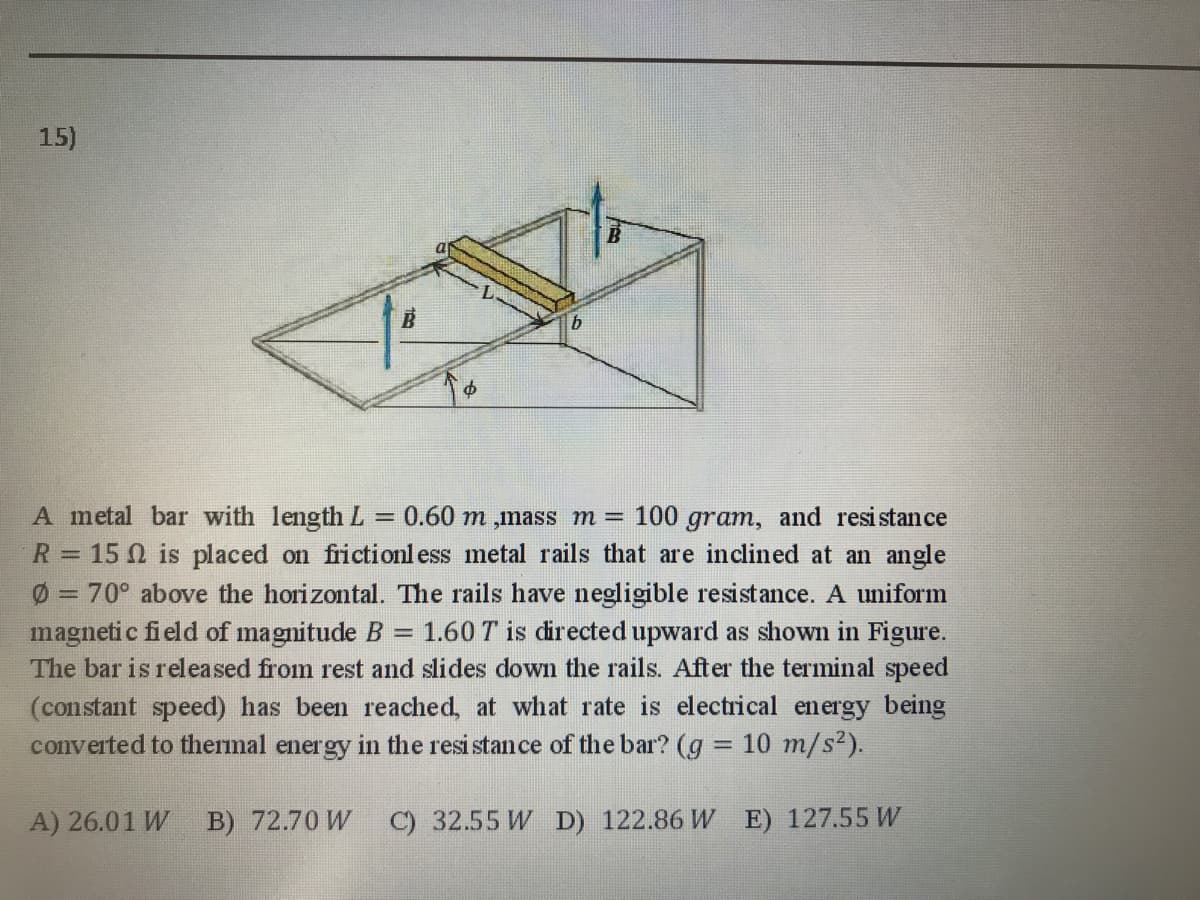15) A metal bar with lengthL = 0.60 m ,mass m = 100 gram, and resistance R= 15 0 is placed on frictionl ess metal rails that are inclined at an angle Ø = 70° above the horizontal. The rails have negligible resistance. A uniform %3D %3D 1.60 T is directed upward as shown in Figure. magnetic field of magnitude B The bar is released from rest and slides down the rails. After the terminal speed (constant speed) has been reached, at what rate is electrical energy being converted to thermal energy in the resistance of the bar? (g = 10 m/s2). %3D A) 26.01 W B) 72.70 W C) 32.55 W D) 122.86 W E) 127.55 W
15) A metal bar with lengthL = 0.60 m ,mass m = 100 gram, and resistance R= 15 0 is placed on frictionl ess metal rails that are inclined at an angle Ø = 70° above the horizontal. The rails have negligible resistance. A uniform %3D %3D 1.60 T is directed upward as shown in Figure. magnetic field of magnitude B The bar is released from rest and slides down the rails. After the terminal speed (constant speed) has been reached, at what rate is electrical energy being converted to thermal energy in the resistance of the bar? (g = 10 m/s2). %3D A) 26.01 W B) 72.70 W C) 32.55 W D) 122.86 W E) 127.55 W
College Physics
10th Edition
ISBN:9781285737027
Author:Raymond A. Serway, Chris Vuille
Publisher:Raymond A. Serway, Chris Vuille
Chapter19: Magnetism
Section19.3: Magnetic Fields
Problem 19.1QQ: A charged particle moves in a straight line through a region of space. Which of the following...
Related questions
Question
if you can send the solution fast that would be amazing thank you!

Transcribed Image Text:15)
A metal bar with lengthL = 0.60 m ,mass m = 100 gram, and resistance
R= 15 0 is placed on frictionl ess metal rails that are inclined at an angle
Ø = 70° above the horizontal. The rails have negligible resistance. A uniform
%3D
1.60 T is directed upward as shown in Figure.
magneti c field of magnitude B
The bar is released from rest and slides down the rails. After the terminal speed
(constant speed) has been reached, at what rate is electrical energy being
converted to thermal energy in the resi stan ce of the bar? (g = 10 m/s2).
%3D
A) 26.01 W B) 72.70 W
C) 32.55 W D) 122.86 W E) 127.55 W
Expert Solution
This question has been solved!
Explore an expertly crafted, step-by-step solution for a thorough understanding of key concepts.
This is a popular solution!
Trending now
This is a popular solution!
Step by step
Solved in 2 steps with 2 images

Knowledge Booster
Learn more about
Need a deep-dive on the concept behind this application? Look no further. Learn more about this topic, physics and related others by exploring similar questions and additional content below.Recommended textbooks for you

College Physics
Physics
ISBN:
9781285737027
Author:
Raymond A. Serway, Chris Vuille
Publisher:
Cengage Learning

College Physics
Physics
ISBN:
9781305952300
Author:
Raymond A. Serway, Chris Vuille
Publisher:
Cengage Learning

Physics for Scientists and Engineers, Technology …
Physics
ISBN:
9781305116399
Author:
Raymond A. Serway, John W. Jewett
Publisher:
Cengage Learning

College Physics
Physics
ISBN:
9781285737027
Author:
Raymond A. Serway, Chris Vuille
Publisher:
Cengage Learning

College Physics
Physics
ISBN:
9781305952300
Author:
Raymond A. Serway, Chris Vuille
Publisher:
Cengage Learning

Physics for Scientists and Engineers, Technology …
Physics
ISBN:
9781305116399
Author:
Raymond A. Serway, John W. Jewett
Publisher:
Cengage Learning

College Physics
Physics
ISBN:
9781938168000
Author:
Paul Peter Urone, Roger Hinrichs
Publisher:
OpenStax College


Glencoe Physics: Principles and Problems, Student…
Physics
ISBN:
9780078807213
Author:
Paul W. Zitzewitz
Publisher:
Glencoe/McGraw-Hill